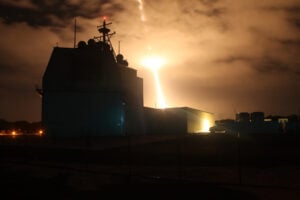Japan Aegis Ship Tracks, Destroys Ballistic Missile
Posted on
PENTAGON: A Japanese Atago-class destroyer successfully knocked down a mock ballistic missile off the coast of Hawaii today in another sign of Japan’s push to quickly beef up its missile defenses.
It was the second time a Japanese ship armed with the Aegis Ballistic Missile Defense system was able to intercept a ballistic missile, the first being in February 2017. A second test in June of last year failed, but the Navy blamed sailor error for that miss after the interceptor blew up in flight.
The Missile Defense Agency on Wednesday said that the JS Atago tracked the missile fired from Barking Sands Hawaii and hit it with an SM-3 Block 1B TU interceptor over the Pacific.
Japan has been investing heavily in ballistic missile defenses given the ongoing threats from both China and North Korea. Also, Japanese officials are skeptical of the chances for success in the talks between President Trump and North Korean strongman Kim Jong Un.
“We cannot avert our eyes from the harsh fact that several hundred ballistic missiles whose range covers our country still exist in reality,” the Defense Ministry said in a statement in July.
By 2021, plans call for Japan to have eight Aegis destroyers at sea, four of which will be capable of launching SM-3 Block IIA missiles — including two new Aegis-equipped Maya-class destroyers, the first of which is set for delivery in 2020.
In July, Tokyo announced that it was also planning to buy two ground-based Aegis Ashore systems from Lockheed Martin for $1.2 billion to provide another layer of protection against any North Korean ballistic missile strike, a move that underscores Japanese unease at the Chinese military buildup and the continuing North Korean threat.
The Aegis Ashore systems were included in the release last month of Japan’s new defense budget, which asks for a record $48 billion for their fiscal year which begins April 1.
Overall, the Abe government is looking to spend $3.8 billion on missile defense systems, part of the $6.2 billion Tokyo is planning to spend on U.S. systems under the Foreign Military Sales program.
Other big-ticket items include $480 million to modernize F-15 fighters to allow them to carry cruise missiles and increase their electronic warfare prowess, $820 million for six F-35s fighters and $830 million for various space and cyber defense programs.
According to current plans, the Aegis Ashore units won’t be operational until 2025. When active, they will be able to link up with the ship-based systems to provide a deeper defense against North Korean missiles.
“This successful test is a major milestone verifying the capabilities of an upgraded Aegis BMD configuration for Japan’s destroyers,” MDA Director Lt. Gen. Samuel Greaves said in a statement. “This success provides confidence in the future capability for Japan to defeat the developing threats in the region.”
While Japan is rapidly upgrading its ground and sea missile defenses, some leaders in the Pentagon are increasingly looking to space.
Speaking at an event on Capitol Hill last week, Michael Griffin, undersecretary of defense for research and engineering, suggested that a network of 1,000 missile interceptors deployed on satellite launchers could be built for $20 billion — far less than other estimates that put any such system in the hundreds of billions.

The X-51A Waverider is set to demonstrate hypersonic flight. Powered by a Pratt Whitney Rocketdyne SJY61 scramjet engine, it is designed to ride on its own shockwavem and accelerate to about Mach 6. (U.S. Air Force graphic)
Griffin said that existing systems aren’t able to detect the new hypersonic missiles being developed by China and Russia, and the only way to truly spot them in time is from space.
China has already run “dozens” of tests on hypersonic missiles, Griffin said, and is far ahead of the United States in weaponizing that technology.
“We just can’t do what we need to do in missile defense without space,” he warned, adding, “in brief, we do not have systems today that give us globally, comprehensive, persistent, timely, multi-mode awareness of what is going on on earth, everywhere, all the time. We don’t have that.”
Undersecretary of defense for policy John Rood, sitting alongside Griffin, said that “space is an increasing focus at the Defense Department,” and we’re looking very seriously at capabilities that could be employed for space-based missile defenses, whether that be sensors or other capabilities.”
Subscribe to our newsletter
Promotions, new products and sales. Directly to your inbox.


